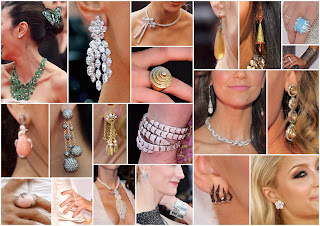Thursday, November 18, 2010
Saturday, October 16, 2010
Monday, April 5, 2010
Misleading Gemstone Names
Misleading Gemstone Names
Read jewelry ads and you'll see descriptive terms tacked-on to the names of gemstones, like Oriental emerald (it's really a green sapphire), American ruby (a garnet) and Australian jade (treated quartz).
Sometimes extra terms do describe the source or type of gem that's being advertised, but many are deceptive, and some sellers hope you won't notice that they replace what you think is a more expensive gem with either a look-alike gem that's less expensive or components made from glass and other materials.
There are hundreds and hundreds of examples of misleading gemstone names. Here are some of the most common.
Diamond Impostors
German diamond: quartz
Herkimer diamond: double-terminated quartz
Bohemian Diamond: quartz
Most of the stones advertised with diamond in the name, but with a qualifying term in front of the word, are quartz.
Emerald Impostors
African emerald: green fluorite
Bohemian emerald: green fluorspar
Broghton emerald: green glass
Chatham emerald: synthetic emerald
Cape emerald: Prehnite
Gilson emerald: synthetic emerald
Emeraldine: chalcedony that's dyed green
Oriental emerald: sapphire
Evening emerald: peridot
Spanish emerald: glass
Ruby Impostors
Adelaide ruby: Australian garnet
Australian ruby: garnet
Bohemian ruby: garnet
California ruby: garnet
Cape ruby: garnet
Montana ruby: garnet
San Diego ruby: red tourmaline
Siberian ruby: tourmaline
Sapphire Impostors
Brazilian sapphire: blue tourmaline
Burma sapphire: synthetic sapphire
Hope sapphire: synthetic blue spinel or lab grown sapphire
True sapphire is sometimes called descriptive names, like Kashmir sapphire, which is a deep blue version of the gem, but most of today's sellers use the stone's color as a descriptive label.
Jade Impostors
African jade: garnet
Colorado jade: feldspar
Honan jade: soapstone
Indian jade: aventurine
Manchurian jade: soapstone
Swiss jade: jasper
Pearl Impostors
Atlas pearls: calcite beads
Delta pearls: imitations
Roman pearls: glass beads
Swarovski pearls: glass beads
Opal Impostors
Ceylon opal: moonstone
Blue opal: lazulite
Lapis Impostors
Swiss lapis: chalcedony or dyed jasper
German lapis: dyed jasper
Canadian lapis: sodalite
Turquoise Impostors
African turquoise: jasper
Chinese turquoise: calcite, soapstone
Sacred turquoise: smithsonite
Utah turquoise: variscite
Vienna turquoise: simulated at one time but may contain reconstituted turquoise
Yellow turquoise: often jasper or serpentine
Amazonite and chrysocolla are two gemstones that resemble turquoise and are sometimes confused with it.
The jewelry made from "impostor" gems might be just what you're looking for, so don't hesitate to buy it, but do some homework before you make a purchase so that you understand exactly what you are buying.
Wednesday, March 3, 2010
March Birthstone : Aquamarine
Poetically described as 'exhibiting the color of seawater parted by the bow of a sailing ship', and symbolizing 'eternal youth and happiness' since ancient times, aquamarine is a variety of beryl family of minerals, of which emerald is also a member.
High quality aquamarine is almost entirely free of inclusions, and exhibits wonderful shine. Iron is the substance, which gives aquamarine its enchanting color, a color that ranges from an almost indiscernible pale blue to a strong sea-blue. Some aquamarines have a light, greenish shimmer which is also a typical feature of this translucent azure gemstone, but it is the pure, clear blue that continues to epitomize the aquamarine, because it brings out so well the immaculate transparency and magnificent shine of this coveted gemstone.
The various color nuances of aquamarine have been given melodious names: The rare, intense blue aquamarines from the Santa Maria de Itabira mine in Brazil, for example, are called 'Santa Maria'. Similar nuances come from a few gemstone mines in Africa, particularly Mozambique. To help distinguish them from the Brazilian ones, these aquamarines have been given the name 'Santa Maria Africana'.
According to legend, aquamarine originated in the treasure chest of fabulous mermaids, and was regarded as the sailors' lucky stone in ancient times. Ancient sailors traveled with aquamarine crystals, believing that it would ensure a safe voyage, and guarantee a safe return; they often slept with the stones under their pillow to ensure sound sleep.
The name of aquamarine is derived from the Latin words 'aqua' (water) and 'mare' (sea). It is believed that its strengths are developed more positively when it is placed in water and bathed in sunlight. However, according to the old traditions, wearing aquamarine per se promises a happy marriage and bestows joy and wealth upon its wearer.
The tender blue color of aquamarine arouses feelings of sympathy, trust, harmony, and friendship, feelings that prove their worth in lasting relationships. The blue of aquamarine is considered a divine, eternal color, because it is the color of the sky and the color of water with its life-giving force.
There is hardly any other gemstone in modern jewelry design which is refined in such a variety of ways as aquamarine. Whether fashioned as a clear, transparent gem in the classical step cut, or creatively cut in a more modern design, it is always alluringly beautiful and can produce the most fascinating creations. For decades, it has been amongst the most favorite gemstones of designers, who have often taken the world by surprise with a new, artistic cut, to be applied in their 'avant-garde' jewelry pieces, hence contributing to the widespread popularity of aquamarine. The lucid color of aquamarine enables the designers to bring out the brilliance of aquamarine with fine grooves, curves and edges. By doing so, each aquamarine becomes a unique specimen, whose magical attraction can hardly be resisted.
Posted by Unknown at 9:40 AM 1 comments
Labels: Gemstone
Tuesday, January 26, 2010
Jewelry Trends on the SAG Awards Red Carpet, 2010
Posted by Unknown at 3:32 PM 0 comments
Labels: Celebrities, Jewelry, Red Carpet








